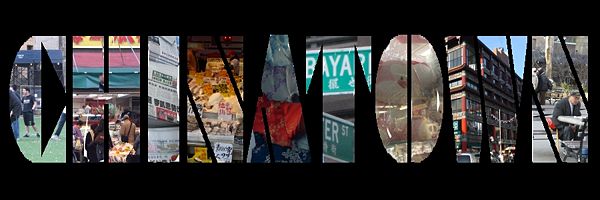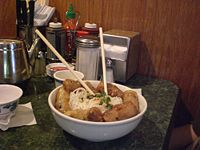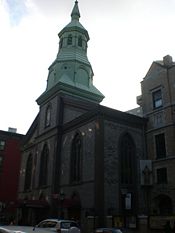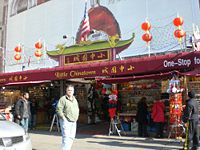From The Peopling of New York City

History -- Culture -- Demographics -- Landmarks and Attractions -- Economy
Culture
The Chinese culture is alive and well in the streets of Chinatown. Although the neighborhood’s inhabitants are not as exclusively Chinese as it once used to be, there is no doubt that Chinese traditions and customs are still prevalent today. From the dim sum luncheons to the annual Spring Festival, Manhattan’s Chinatown offers residents and tourists alike the opportunity to experience and celebrate the Chinese culture.
The variety of Asian cuisine that can be found in Chinatown has become a popular draw for all different types of people. Aside from Chinese entrees, one can expect to find numerous restaurants offering up some of the most characteristic dishes from their respective countries. There is a selection of places with Vietnamese, Thai, and Malaysian foods among others. Furthermore, there are countless other cafes and bakeries specializing on certain Chinese delicacies. Bubble tea, a sweet concoction of milk, flavored tea, and tapioca balls, has become a popular drink and is sold in many places. Teahouses in general reflect a larger scope of the popularity of tea within the Asian population; for China, tea has long been one of its main exports[1].

A Vietnamese dish from the restaurant Nam Son, just one example of the variety of Asian cuisine that can be found throughout Chinatown.
After the downturn of Chinatown’s economy due to the 9/11 attacks, food festivals were organized to help give the market a boost[2]. “Taste of Chinatown” is a mixture of samplings of all the different kinds of food that can be found throughout the neighborhood. It draws thousands of people because of the cheap prices and exquisite tastes of various dishes; one can have Peking duck, pork buns, dim sum, dumplings, among other foods for just a few dollars each[3].
The Spring Festival however is what draws the most interest in Chinatown, which typically occurs during January and/or February of every year and encompasses the 15-day affair of the Chinese (or Lunar) New Year celebrations[4]. The Chinese culture is well preserved in these festivities as the streets of Chinatown are littered with streamers, Chinese lanterns, and “red envelopes of cash,” many of which were in one way or another symbols of good luck[5]. The Chinese New Year is a celebration that is actually also a practice of many traditional superstitious beliefs. For example, the color red is believed to be of good fortune, and the loud noise made by firecrackers are said to ward off evil spirits[6]. At one point in the late 1990s, former New York City Mayor Rudolph Giuliani placed a ban on firecrackers as a safety precaution. Since then, the ban was lifted and firecrackers are once again part of the Chinese New Year celebrations[7]. Lion dances, kung fu exhibitions, and a variety of Chinese music are also part of the annual festivities.
This YouTube video captures a lion dance performed by the Chinatown Community Young Lions. Lion dances are just one of the many attractions that bring people to Chinatown during the Spring Festival.
There is also something to be said about the religious culture of Chinatown. As Jennifer Lee notes in a New York Times article, the Church of the Transfiguration is a multilayered organization that is reaching out to the different populations that make up its religious community. For their Christmas services, the Church of the Transfiguration, which houses the “largest Chinese Roman Catholic congregation in the United States,” offers a mass in English (partly to serve the Italian-Americans that still go there), one in Cantonese, and yet another in both Mandarin and English for the growing Fujianese community of Chinatown[8].
For many of the new immigrants arriving in Chinatown, their religious beliefs are a strong identifier of who they are. As the number of the Asian population grows, so does Asian participation in religious activities, as noted by Jennifer Phillips in an article for Columbia News Service[9]. Phillips (as does Lee in her New York Times article) studies how the religious place of worship is also an extension of the Asian immigrant community as a whole. Along with the Church of the Transfiguration, the Episcopal Church of Our Savior, and other such places are all part of the social networking for these people. The churches have also taken notice of this fact. For example, the Episcopal Church of Our Savior hold luncheons after services at which time the congregation is able to get together at least once a week in order to just mingle with each other, and therefore helping them to assimilate to the American way of life, while at the same time also preserving their original culture[10]. The multilingual masses and the societal aspect that churches like these offer make it easier for immigrants to settle into their new home.
Culture in Pictures
A selection of Chinese newspapers sold at a local newsstand.
|
The entrance to the Mahayana Buddhist Temple located on Canal Street. For more about the temple, please see Landmarks and Attractions.
|
Vegetables sold at one of the many crowded outdoor markets in Chinatown.
|
An example of Chinese-style architecture on some of the buildings in the neighborhood.
|
A store shows off the choice of poultry they have, popular in Asian cuisine.
|
A Baptist church's sign showing that they offer multilingual services.
|
A grocery store serving Thai specialties, just another one of the Asian cultures represented in Chinatown.
|
Chinese/Asian style clothing on street side mannequins.
|
A gift shop that sells traditional Chinese items, like the lanterns.
|
|
|
References
- ↑ Explore Chinatown, “Discover Chinatown NYC: Food & Etiquette,” 17 March 2008, <http://www.explorechinatown.com/Gui/Content.aspxPage=Discover&Type=FoodEtiquette&Specialty=Tea.htm> (22 March 2008)
- ↑ Anthony Ramirez, “Food Festival in Chinatown Draws Thousands, but Chilly Rain Forces Early Closing,” The New York Times on the Web, 23 April 2006, <http://www.nytimes.com/2006/04/23/nyregion/23chinatown.html?_r=2&scp=1&sq=chinatown+culture&st=nyt&oref=slogin&oref=slogin||http://www.nytimes.com> (8 March 2008)
- ↑ Ramirez, “Food Festival.”
- ↑ Chinatownology, “Chinese New Year,” 22 March 2008, <http://www.chinatownology.com/
chinese_new_year.htm> (4 April 2008)
- ↑ Vivian S. Toy, “My New Year in Chinatown: The Bang Is Gone,” The New York Times on the Web, 1 February 1998, <http://query.nytimes.com/gst/fullpage.html?res=9A04E2D7153AF932A35751C0A96E958260> (8 March 2008)
- ↑ Toy, “My New Year in Chinatown.”
- ↑ Better Chinatown, “Firecracker Ceremony,” 5 February 2008, <http://www.betterchinatown.com/firecracker.html> (4 April 2008)
- ↑ Jennifer Lee, “In Chinatown, a Church Speaks in Several Languages, but With One Strong Voice,” The New York Times on the Web, 25 December 2007, <http://www.nytimes.com/2007/12/25/nyregion/25mass.html_r=3&st=cse&sq=chinatown&scp=9&oref=slogin&oref=slogin&oref=slogin> (4 April 2008)
- ↑ Jennifer Phillips, “Asian Churches Serve Up Religion and Community,” Columbia News Service, 28 February 2006, <http://jscms.jrn.columbia.edu/cns/2006-02-28/phillips-asianchurches/> (4 April 2008)
- ↑ Phillips, “Asian Churches Serve Up Religion and Community.”
[[History]] [[Culture]] [[Demographics]] [[Landmarks and Attractions]] [[Economy]]














